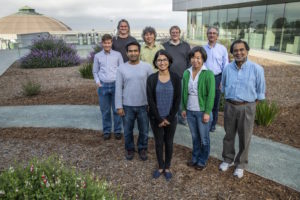
Berkeley Lab researchers (front row, from left) Iris Young, Sheraz Gul, Ruchira Chatterjee, Junko Yano, Vittal Yachandra, (back, from left) Nigel Moriarty, Jan Kern, Aaron Brewster, and Nicholas Sauter. (Credit: Marilyn Chung/Berkeley Lab)
Despite its pivotal role in shaping life as we know it, many aspects of photosynthesis remain a mystery. An international collaboration led by scientists at Berkeley Lab and SLAC National Accelerator Laboratory is working to change that.
Using SLAC’s Linac Coherent Light Source (LCLS) X-ray laser, the team captured the most complete and highest resolution picture to date of photosystem II. This workhorse protein complex found in plants, algae, and cyanobacteria is responsible for using sunlight to break water down into its atomic components, unlocking hydrogen and oxygen.
Until recently, it had only been possible to measure pieces of this process at extremely low temperatures. In a previous paper, the researchers—led by Jan Kern, Vittal Yachandra, and Junko Yano in Biosciences’ Molecular Biophysics and Integrated Bioimaging (MBIB) Division—used a new method to observe two steps of this water-splitting cycle at the temperature at which it occurs in nature.
Now, using the same technique, the team has imaged all four stable oxidation states (S0-S3) of the process at natural temperature and the finest level of detail yet. They also captured, for the first time, fleeting transitional moments between two of the states, giving them a sequence of six images of the process. The results were published in Nature.
The LCLS creates ultrafast X-ray laser pulses that allow scientists to collect both X-ray crystallography and spectroscopy data before the sample is destroyed. MBIB researchers Nicholas Sauter and Paul Adams, also co-authors of the paper, developed critical software and algorithms that provided a completely new way of analyzing the data from the X-ray laser.
Key components of the work were carried out at SLAC’s Stanford Synchrotron Radiation Lightsource (SSRL), Berkeley Lab’s Advanced Light Source (APS), and Argonne National Laboratory’s Advanced Photon Source (APS), all of which are DOE Office of Science user facilities.
In addition to Berkeley Lab and SLAC, the collaboration included researchers from Umeå and Uppsala Universities in Sweden, Humboldt University of Berlin in Germany, the Diamond Light Source in England, UC San Francisco, and UC Berkeley.
Read more in the Berkeley Lab News Center.
Read the SLAC press release.




